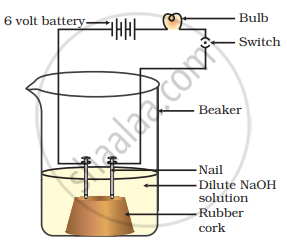Advertisements
Advertisements
Questions
Equal lengths of magnesium ribbons are taken in test tubes A and B. Hydrochloric acid (HCl) is added to test tube A, while acetic acid (CH3COOH) is added to test tube B. In which test tube will the fizzing occur more vigorously, and why?
Equal lengths of magnesium ribbons are taken in test tubes A and B. Hydrochloric acid (HCl) is added to test tube A, while acetic acid (CH3COOH) is added to test tube B. The amount and concentration taken for both acids are the same. In which test tube will the fizzing occur more vigorously, and why?
Solution 1
The fizzing will occur strongly in test tube A, in which hydrochloric acid (HCl) is added. This is because HCl is a stronger acid than CH3COOH and therefore produces hydrogen gas at a faster speed, due to which fizzing occurs.
Solution 2
HCl is a strong acid, whereas acetic acid is a weaker acid. Fizzing occurs because the hydrogen gas evolves by reacting with the acid on the magnesium ribbon. Since HCl is a very strong acid, there is a lot of hydrogen gas liberated from test tube A. Therefore, more fizzing takes place in test tube A.
APPEARS IN
RELATED QUESTIONS
Why does an aqueous solution of an acid conduct electricity?
What happens when an acid reacts with a metal hydrogencarbonate? Write equation of the reaction which takes place.
Name the gas evolved when zinc granules are treated/heated with:
hydrochloric acid solution
What ions are present in the solutions of following substances? (write the symbols only)
Hydrochloric acid
What ions are present in the solutions of following substances? (write the symbols only)
Sulphuric acid
Define an acid and a base. Give two examples of each.
Hydrochloric acid reacts with a metal X to form a gas Y which burns with a 'pop' sound. Sodium hydroxide solution also reacts with the same metal X (on heating) to form the same gas Y.
Name X and Y
Hydrochloric acid reacts with a metal X to form a gas Y which burns with a 'pop' sound. Sodium hydroxide solution also reacts with the same metal X (on heating) to form the same gas Y.
Write the chemical equation of the reaction of metal X with (i) hydrochloric acid, and (ii) sodium hydroxide solution.
Name a metal compound which has detergent properties (cleansing properties).
If you take some distilled water in a test-tube, add an equal amount of acetic acid to it, shake the test-tube well and leave it undisturbed on the test-tube stand, then after about 5 minutes what would you observe?
(A) There is a layer of water over the layer of acetic acid.
(B) A precipitate is setting at the bottom of the test-tube.
(C) Bubbles of colourless gas are coming out of the test-tube.
(D) There is a clear, colourless transparent solutions in the test-tube.
Magnesium hydroxides are used for treating _______
Write any four physical properties of acids.
If a few drops of a concentrated acid accidentally spills over the hand of a student, what should be done?
In an attempt to demonstrate electrical conductivity through an electrolyte, the apparatus setup. Which among the following statement(s) is(are) correct?

- Bulb will not glow because electrolyte is not acidic
- Bulb will glow because NaOH is a strong base and furnishes ions for conduction.
- Bulb will not glow because circuit is incomplete
- Bulb will not glow because it depends upon the type of electrolytic solution
Which of the following is used for dissolution of gold?
Which of the following statements is true for acids?
What are strong and weak acids? In the following list of acids, separate strong acids from weak acids.
Hydrochloric acid, citric acid, acetic acid, nitric acid, formic acid, sulphuric acid.
Take a clean test tube with a holder and pour some dilute hydrochloric acid. Add a few pieces of magnesium ribbon pieces slowly. What do you observe? Now show a burning match stick near the mouth of the test tube. Do you hear any sound? The gas burns with a pop sound. From this, it is observed that hydrogen gas has been formed due to the reaction between acid and metal.
______ & ______ metals do not react with HCl or HNO3.
The formula of bleaching powder is ______.
